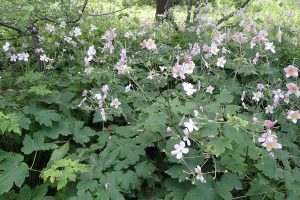 The genus Anemone consists of over 120 species and is a member of the buttercup family, Ranunculaceae, that also includes delphinium, clematis, and hellabore. The garden worthy species are usually perennial and found in temperate and subarctic regions. Plants have mostly basal leaves that may be palmately divided or lobed and toothed, or palmately compound with smaller stem leaves in pairs or whorls below the flowers. The flowers lack petals and but have showy 5-20 petal-like sepals that are usually white but may be creamy yellow, pink, blue, or reddish purple, depending on the species. The bloom time varies with some species blooming in early spring, others in summer or fall. The fruit is a single seeded achene, sometimes with woolly hairs, and persist into winter. The root system is usually fibrous but is sometimes a tuber. Anemones generally do well in some shade or full sun and in average consistently moist soil. Hardiness varies considerably from USDA Hardiness Zones 2 to tender plants that need at least zone 9. Anemones are generally healthy and have no major pest or disease problems. Propagation of fibrous species is usually by division root cutting or seed; tuberous species are best propagated by lifting and dividing the tubers as soon as the plants become dormant in spring and replanting in fall after soaking them in water for 12 hours. The genus name, Anemone, is probably a corrupted Greek loan word of Semitic origin referring to the lament for the slain Adonis or Naaman, whose scattered blood produced the blood-red Anemone coronaria. Photo Credit: Wikimedia
The genus Anemone consists of over 120 species and is a member of the buttercup family, Ranunculaceae, that also includes delphinium, clematis, and hellabore. The garden worthy species are usually perennial and found in temperate and subarctic regions. Plants have mostly basal leaves that may be palmately divided or lobed and toothed, or palmately compound with smaller stem leaves in pairs or whorls below the flowers. The flowers lack petals and but have showy 5-20 petal-like sepals that are usually white but may be creamy yellow, pink, blue, or reddish purple, depending on the species. The bloom time varies with some species blooming in early spring, others in summer or fall. The fruit is a single seeded achene, sometimes with woolly hairs, and persist into winter. The root system is usually fibrous but is sometimes a tuber. Anemones generally do well in some shade or full sun and in average consistently moist soil. Hardiness varies considerably from USDA Hardiness Zones 2 to tender plants that need at least zone 9. Anemones are generally healthy and have no major pest or disease problems. Propagation of fibrous species is usually by division root cutting or seed; tuberous species are best propagated by lifting and dividing the tubers as soon as the plants become dormant in spring and replanting in fall after soaking them in water for 12 hours. The genus name, Anemone, is probably a corrupted Greek loan word of Semitic origin referring to the lament for the slain Adonis or Naaman, whose scattered blood produced the blood-red Anemone coronaria. Photo Credit: Wikimedia
Apeninnes anemone (A. apeninna)
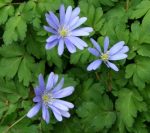 Native to southern central Europe, Apeninne anemone is a spring blooming plant that grows 6-8″ tall and has 1-1.5″ long leaves that are toothed and deeply lobed. The solitary semi-double flowers are 1.5′ across, have 10-15 narrow sky-blue sepals, and are subtended by 3 stem leaves. Plants go dormant after blooming. A good choice for a rock garden, informal garden, and as an underplanting of shrubs. Photo Credit: Wikimedia
Native to southern central Europe, Apeninne anemone is a spring blooming plant that grows 6-8″ tall and has 1-1.5″ long leaves that are toothed and deeply lobed. The solitary semi-double flowers are 1.5′ across, have 10-15 narrow sky-blue sepals, and are subtended by 3 stem leaves. Plants go dormant after blooming. A good choice for a rock garden, informal garden, and as an underplanting of shrubs. Photo Credit: Wikimedia
Height: 6-8″
Bloom Time: Spring
Bloom Color: Blue (white cultivars available)
Hardiness: Zones 6-9
Grecian Windflower (A. blanda)
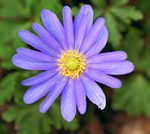 Native to southeastern Europe, Turkey, Lebanon, and Syria, Grecian windflower grows 6-8″ high from a tuberous root system and has softly hairy fern-like leaves that are 3″ wide and dissected into 3 deeply cut segments. The daisy-like flowers appear in early spring and can last a month, especially if in an area protected from the wind. They are 2″ across and have colorful blue sepals surrounding the center of yellow stamens. Cultivars are available in various shades of blue, white, pink and purplish red. They can bring early color to a rock garden, perennial border, or open woodland with equal success and are especially attractive when planted in large drifts. Plants go dormant after flowering. Photo Credit: Wikipedia
Native to southeastern Europe, Turkey, Lebanon, and Syria, Grecian windflower grows 6-8″ high from a tuberous root system and has softly hairy fern-like leaves that are 3″ wide and dissected into 3 deeply cut segments. The daisy-like flowers appear in early spring and can last a month, especially if in an area protected from the wind. They are 2″ across and have colorful blue sepals surrounding the center of yellow stamens. Cultivars are available in various shades of blue, white, pink and purplish red. They can bring early color to a rock garden, perennial border, or open woodland with equal success and are especially attractive when planted in large drifts. Plants go dormant after flowering. Photo Credit: Wikipedia
Height: 6-8″
Bloom Time: Early spring
Bloom Color: Blue; cultivars in various shades of blue, pink, white, purplish red
Hardiness: Zones 5-8
Meadow Anemone (A. canadensis aka A. pennsylvanica)
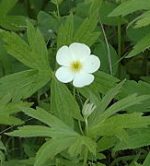 A North American native of moist meadows, streams banks, and open woods, this herbaceous perennial is a member of the buttercup family, Ranunculaceae, that also includes delphinium, clematis, and hellebore. It grows 1-2″ tall and has light green leaves that are 6-8″ long and deeply cut into 5-7 toothed parts with hairs on the undersides. The 1-2” wide white flowers appear in loose clusters of 3-5 on slender stems in spring. They have 4-5 showy white sepals surrounding a golden center of stamens. Meadow anemone is a vigorous grower in its natural environment and can be invasive but is better behaved in drier sites. It naturalizes easily and is especially attractive when allowed to form a large colony in wildflower or native plant gardens. Photo credit: Wikipedia
A North American native of moist meadows, streams banks, and open woods, this herbaceous perennial is a member of the buttercup family, Ranunculaceae, that also includes delphinium, clematis, and hellebore. It grows 1-2″ tall and has light green leaves that are 6-8″ long and deeply cut into 5-7 toothed parts with hairs on the undersides. The 1-2” wide white flowers appear in loose clusters of 3-5 on slender stems in spring. They have 4-5 showy white sepals surrounding a golden center of stamens. Meadow anemone is a vigorous grower in its natural environment and can be invasive but is better behaved in drier sites. It naturalizes easily and is especially attractive when allowed to form a large colony in wildflower or native plant gardens. Photo credit: Wikipedia
Height: 1-2′
Bloom Time: Spring
Bloom Color: White
Hardiness: Zones 3-7
Poppy Anemone (A. coronaria)
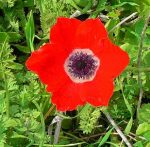 Poppy anemone is a tuberous short-lived perennial native to the Mediterranean. The 2″ wide poppy-like flowers can be red, white, pink, purple or blue with dark centers and are carried singly on stems six to eighteen inch tall in early spring. Both single and double flowered cultivars are available. The medium green leaves are 1-2″ long, divided and fern-like but disappear in the summer when the plants go dormant. Poppy anemone tends to be short-lived and is best treated as an annual by fall planting tubers that have been soaked in water for 12 hours. Plants can be grown in containers and are excellent cut flower. Photo Credit: Wikipedia
Poppy anemone is a tuberous short-lived perennial native to the Mediterranean. The 2″ wide poppy-like flowers can be red, white, pink, purple or blue with dark centers and are carried singly on stems six to eighteen inch tall in early spring. Both single and double flowered cultivars are available. The medium green leaves are 1-2″ long, divided and fern-like but disappear in the summer when the plants go dormant. Poppy anemone tends to be short-lived and is best treated as an annual by fall planting tubers that have been soaked in water for 12 hours. Plants can be grown in containers and are excellent cut flower. Photo Credit: Wikipedia
Height: 7-15″
Bloom Time: Early spring
Bloom Color: Red, white, blue, pink with dark center
Hardiness: Zones 6-9
Hybrid Japanese Anemone (A. x hybrida)
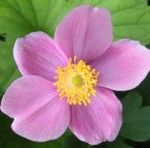 This hybrid anemone forms a substantial mound of handsome dark green leaves that are palmately compound with three toothed leaflets. The flowers are two to five inches across and have white or pink showy sepals that that surround a yellow center. Flowers may be single, semi-double or double and appear on wiry well branched stems in late summer into fall over a long bloom time. Plants may be slow to flower and once established can be very vigorous. Both the leaves and flowers are good in the vase together or separately. There are many outstanding cultivars available. Photo Credit: Wikipedia
This hybrid anemone forms a substantial mound of handsome dark green leaves that are palmately compound with three toothed leaflets. The flowers are two to five inches across and have white or pink showy sepals that that surround a yellow center. Flowers may be single, semi-double or double and appear on wiry well branched stems in late summer into fall over a long bloom time. Plants may be slow to flower and once established can be very vigorous. Both the leaves and flowers are good in the vase together or separately. There are many outstanding cultivars available. Photo Credit: Wikipedia
Height: 2-5′
Bloom Time: Late summer into fall
Bloom Color: White or pink
Hardiness: Zones 4-8
Lesser’s Anemone ( A. x lesseri)
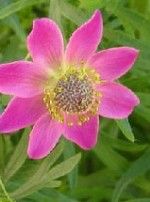 Lesser’s anemone , also called rose windflower, was produced from a cross between Anemone multifida and A. sylvestris. The fern-like basal leaves are glossy, five inches wide, palmately divided into three to five segments, and somewhat hairy along the midrib and veins. The flowers appear in the early summer and are 1 1/2 to 2 inches across. They are carried singly or in umbels of two to three on erect stalks and have five to nine colorful petal-like sepals that may yellow, white, red, rose, or purple, although deep rose and red are most common. The plants are heat tolerant and do well in the South but need afternoon shade. A good choice for the front of the border, an open woodland planting, or a rockery. Plants sometimes rebloom in the fall but are short lived. Photo Credit: Wikipedia
Lesser’s anemone , also called rose windflower, was produced from a cross between Anemone multifida and A. sylvestris. The fern-like basal leaves are glossy, five inches wide, palmately divided into three to five segments, and somewhat hairy along the midrib and veins. The flowers appear in the early summer and are 1 1/2 to 2 inches across. They are carried singly or in umbels of two to three on erect stalks and have five to nine colorful petal-like sepals that may yellow, white, red, rose, or purple, although deep rose and red are most common. The plants are heat tolerant and do well in the South but need afternoon shade. A good choice for the front of the border, an open woodland planting, or a rockery. Plants sometimes rebloom in the fall but are short lived. Photo Credit: Wikipedia
Height: 15-18″ H x 12″
Bloom Time:Early summer
Bloom Color: Yellow, white, red, rose, or purple
Hardiness: Zones 5-8
Chinese Anemone (A. hupehensis)
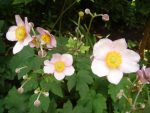 Also called Japaneses anemone, this native of scrub, grassy slopes and streamsides of central China has a thick tuberous root system and forms a 12″ tall basal clump of dark green leaves. The 10-12″ long leaves are toothed, 3 lobed, and have soft hairs on their underside. From late-summer into fall plants produce long, wiry, branching flower stems well above the foliage bearing solitary, cup-shaped flowers that are 2-3″ across and consist of 5-7 rose pink sepals surrounding a center of yellow stamens. Plants are especially valued for the late bloom time and are useful in borders and informal gardens. Photo Credit: Wikimedia
Also called Japaneses anemone, this native of scrub, grassy slopes and streamsides of central China has a thick tuberous root system and forms a 12″ tall basal clump of dark green leaves. The 10-12″ long leaves are toothed, 3 lobed, and have soft hairs on their underside. From late-summer into fall plants produce long, wiry, branching flower stems well above the foliage bearing solitary, cup-shaped flowers that are 2-3″ across and consist of 5-7 rose pink sepals surrounding a center of yellow stamens. Plants are especially valued for the late bloom time and are useful in borders and informal gardens. Photo Credit: Wikimedia
Height: 18-30″
Bloom Time: Late summer into fall
Bloom Color: Rose pink
Hardiness: Zones 4-8
Lesser’s Anemone ( A. x lesseri)
 Lesser’s anemone , also called rose windflower, was produced from a cross between Anemone multifida and A. sylvestris. The fern-like basal leaves are glossy, five inches wide, palmately divided into three to five segments, and somewhat hairy along the midrib and veins. The flowers appear in the early summer and are 1 1/2 to 2 inches across. They are carried singly or in umbels of two to three on erect stalks and have five to nine colorful showy sepals that may be yellow, white, red, rose, or purple, although deep rose and red are most common. The short-lived plants are heat tolerant and do well in the South but need afternoon shade. A good choice for the front of the border, an open woodland planting, or a rockery. Plants sometimes rebloom in the fall. Photo Credit: Wikipedia
Lesser’s anemone , also called rose windflower, was produced from a cross between Anemone multifida and A. sylvestris. The fern-like basal leaves are glossy, five inches wide, palmately divided into three to five segments, and somewhat hairy along the midrib and veins. The flowers appear in the early summer and are 1 1/2 to 2 inches across. They are carried singly or in umbels of two to three on erect stalks and have five to nine colorful showy sepals that may be yellow, white, red, rose, or purple, although deep rose and red are most common. The short-lived plants are heat tolerant and do well in the South but need afternoon shade. A good choice for the front of the border, an open woodland planting, or a rockery. Plants sometimes rebloom in the fall. Photo Credit: Wikipedia
Height: 15-18″ H x 12″
Bloom Time: Early summer
Bloom Color: Yellow, white, red, rose, or purple
Hardiness: Zones 5-8
Magellan Anemone (A. magellanica)
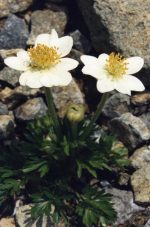 Native to southern South America, this rhizomatous herbaceous perennial grows 6-8″ high and forms tight mounds of ternate dark green leaves that are hairy and further divded into linear lobes. In late spring to early summer the plants produce masses of 12″ long scapes carrying solitary creamy-yellow flowers with gold stamens in the center. The flowers are bowl-shaped, .5 to 1″ wide, and are followed by cottony seedheads that are ornamentally attractive. A good choice for woodland, rock and wildflower gardens. Photo Credit: Wikimedia
Native to southern South America, this rhizomatous herbaceous perennial grows 6-8″ high and forms tight mounds of ternate dark green leaves that are hairy and further divded into linear lobes. In late spring to early summer the plants produce masses of 12″ long scapes carrying solitary creamy-yellow flowers with gold stamens in the center. The flowers are bowl-shaped, .5 to 1″ wide, and are followed by cottony seedheads that are ornamentally attractive. A good choice for woodland, rock and wildflower gardens. Photo Credit: Wikimedia
Height: 6-8:
Bloom Time: Late spring to early summer
Bloom Color: Creamy yellow
Hardiness: Zones 2-7
Narcissus Flowered Anemone (A. narissiflora)
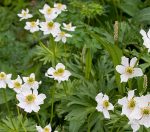 Narcissus flowered anemone is native to northwestern North America and Eurasia where it grows in high mountain grasslands,thickets, grassy meadows, pastures, open woods and along roadsides. It grow from a woody base and forms a compact clump 12-18″ tall. The plants have 3-10 basal palmate leaves that are divided into 3-5 segments, each segment further lobed or toothed. From late spring to early summer the flowers appear singly or in umbels of 2 to 8 flowers , subtended by a involcral ruff. Each 1-1.5″ wide flowers has a center of 40-100 yellow stamens surrounded by 5-7 showy white or pale yellow sepals, sometimes tinged with blue or purple. The fruit is an achene that is winged and has a curved or recurved beak. Plants do best in cool climates and often go dormant when the weather is hot. Good choice for rock or wildflower garden. The species is quite variable and 3 varieties are recognized. Photo Credit: Wikipedia
Narcissus flowered anemone is native to northwestern North America and Eurasia where it grows in high mountain grasslands,thickets, grassy meadows, pastures, open woods and along roadsides. It grow from a woody base and forms a compact clump 12-18″ tall. The plants have 3-10 basal palmate leaves that are divided into 3-5 segments, each segment further lobed or toothed. From late spring to early summer the flowers appear singly or in umbels of 2 to 8 flowers , subtended by a involcral ruff. Each 1-1.5″ wide flowers has a center of 40-100 yellow stamens surrounded by 5-7 showy white or pale yellow sepals, sometimes tinged with blue or purple. The fruit is an achene that is winged and has a curved or recurved beak. Plants do best in cool climates and often go dormant when the weather is hot. Good choice for rock or wildflower garden. The species is quite variable and 3 varieties are recognized. Photo Credit: Wikipedia
Height: 12-18″
Bloom Time: Late spring to early summer
Bloom Color: White with yellow center
Hardiness: Zones 4-7
Wood Anemone (A. nemorosa)
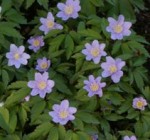 Also known as windflower, this anemone is native to northern and central Europe where it grows in deciduous woodlands. The plants grow 6″ high and spread quickly by creeping rhizomes so can carpet the floor before the trees leaf out. The three-part dark green leaves are produced in late winter to early spring and die in the summer. The flowers have a center of yellow stamens surrounding green stigmas and six to seven petal-like sepals that can be white tinged with pink or lavender. Each flower is about “¾” to “1 ½ “ wide and is produced singly on a short stem just above the foliage in spring. Plants go dormant in summer when the temperatures rise. Many good cultivars are available that vary primarily in color but also in number and size of petals. Good for naturalizing. Photo Credit: Wikipedia
Also known as windflower, this anemone is native to northern and central Europe where it grows in deciduous woodlands. The plants grow 6″ high and spread quickly by creeping rhizomes so can carpet the floor before the trees leaf out. The three-part dark green leaves are produced in late winter to early spring and die in the summer. The flowers have a center of yellow stamens surrounding green stigmas and six to seven petal-like sepals that can be white tinged with pink or lavender. Each flower is about “¾” to “1 ½ “ wide and is produced singly on a short stem just above the foliage in spring. Plants go dormant in summer when the temperatures rise. Many good cultivars are available that vary primarily in color but also in number and size of petals. Good for naturalizing. Photo Credit: Wikipedia
Height: 6″
Bloom Time: Spring
Bloom Color: White often tinged with pink or lavender with yellow center
Hardiness: Zones 4-8
Riverside Anemone (A. rivularis)
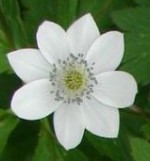 This native of Kashmir, northern India, Tibet, and southwest China grows up to 24″ tall and has dark green leaves that are deeply three-lobed. The flowers have steel blue anthers surrounded by five pure white sepals tinged with blue on the reverse. Each flower is about an inch across, saucer-shaped, and borne on a stiff stem in clusters of three to five in summer. Photo Credit: Wikipedia
This native of Kashmir, northern India, Tibet, and southwest China grows up to 24″ tall and has dark green leaves that are deeply three-lobed. The flowers have steel blue anthers surrounded by five pure white sepals tinged with blue on the reverse. Each flower is about an inch across, saucer-shaped, and borne on a stiff stem in clusters of three to five in summer. Photo Credit: Wikipedia
Height: 24″
Bloom Time: Spring
Bloom Color: White tinged with blue on the reverse and with steel blue anthers
Hardiness: Zones 6-8
Snowdrop Anemone (A. sylvestris)
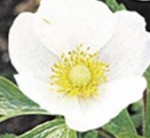 Native to Asia and central and western Europe snowdrop anemone grows in meadows and dry deciduous woodlands. It has light to medium green leaves that are hairy beneath and are divided into three to five toothed segments. The fragrant flowers are 1 ½ to 2 inches across and have five petal-like white sepals surrounding a center of yellow anthers. They are slightly nodding and produced singly on erect stems. Although the primary bloom is in spring, flowers may appear periodically throughout the summer and again in the fall. The fruit is white and woolly. The plants spread by creeping rhizomes and may become a nuisance but are easily removed. Snowdrop anemone is an excellent ground cover for a shade or woodland garden. Photo Credit: Wikipedia
Native to Asia and central and western Europe snowdrop anemone grows in meadows and dry deciduous woodlands. It has light to medium green leaves that are hairy beneath and are divided into three to five toothed segments. The fragrant flowers are 1 ½ to 2 inches across and have five petal-like white sepals surrounding a center of yellow anthers. They are slightly nodding and produced singly on erect stems. Although the primary bloom is in spring, flowers may appear periodically throughout the summer and again in the fall. The fruit is white and woolly. The plants spread by creeping rhizomes and may become a nuisance but are easily removed. Snowdrop anemone is an excellent ground cover for a shade or woodland garden. Photo Credit: Wikipedia
Height: 10-18″
Bloom Time: Spring and periodically thereafter
Bloom Color: White with yellow center
Hardiness: Zones 4-8
Cape Anemone (A. tenuifolia aka A. capensis)
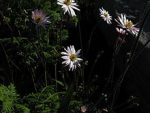 Native to South Africa, this evergreen subshrub grows 12-24″ tall and has a short stem densely covered with leaves that are bi-ternately cut into 3 lobes or 3 segments. From winter to early spring 1-2 blooms appear on flowering stems up to 24 ” tall, well above the foliage. The 3″ wide flowers have as many as 20 narrow sepals that are silky pale pink or mauve, paler inside. Exotic choice for a wildflower garden. Photo Credit: Wikipedia
Native to South Africa, this evergreen subshrub grows 12-24″ tall and has a short stem densely covered with leaves that are bi-ternately cut into 3 lobes or 3 segments. From winter to early spring 1-2 blooms appear on flowering stems up to 24 ” tall, well above the foliage. The 3″ wide flowers have as many as 20 narrow sepals that are silky pale pink or mauve, paler inside. Exotic choice for a wildflower garden. Photo Credit: Wikipedia
Height: 12-24″
Bloom Time: Winter to early spring
Bloom Color: Pale pink to mauve
Hardiness: Zones 9-10
Japanese Anemone (A. tomentosa)
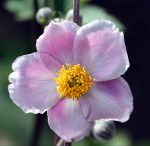 Earlier to flower than other Japanese anemones, this native of open grassy slopes in northern China is also known as windflower. Plants grow from a fibrous root system and form a clump of basal foliage up to 2′ tall. Each dark green leaf is 10-12″ long, palmately divided into three lobed and toothed leaflets that are thickly covered with woolly whitish hairs on their underside. Stems are also covered with whitish woolly hairs. From late summer to early fall cup-shaped flowers appear on 3-4′ long wiry stems. Each flower is 2-3″ wide and has a center of yellow stamens surrounded by 5 or 6 showy sepals that are pale pink with darker rose shadings. A good choice for borders, and informal landscapes such as cottage and woodland gardens. Flowers are good in the vase. Photo Credit: Wikimedia
Earlier to flower than other Japanese anemones, this native of open grassy slopes in northern China is also known as windflower. Plants grow from a fibrous root system and form a clump of basal foliage up to 2′ tall. Each dark green leaf is 10-12″ long, palmately divided into three lobed and toothed leaflets that are thickly covered with woolly whitish hairs on their underside. Stems are also covered with whitish woolly hairs. From late summer to early fall cup-shaped flowers appear on 3-4′ long wiry stems. Each flower is 2-3″ wide and has a center of yellow stamens surrounded by 5 or 6 showy sepals that are pale pink with darker rose shadings. A good choice for borders, and informal landscapes such as cottage and woodland gardens. Flowers are good in the vase. Photo Credit: Wikimedia
Height: 3-4′
Bloom Time: Late summer into fall
Bloom Color: Pale pink with darker rose shadings
Hardiness: Zones 4-7
Tall Anemone (A. virginiana)
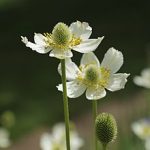
This rhizomatous anemone also known as timbleweed (along with several other plants) is native to rocky and dry open woodlands and dry slopes in central and eastern North America It grows 1-2′ tall and has dark green leaves that are 3 lobed and are clustered in whorls half way up the stem. They may take on reddish tinge in the fall. From early spring to early summer solitary white or greenish-white star-shaped flowers appear that are 1″ wide and have a central mound of numerous greenish or yellowish stamens. They are carried well above the foliage and give way to thimble-shaped seedheads that persist into winter. The plants are useful in woodland, wildlife, native plant, and shade gardens. Tall anemone is not as aggressive as most other anemone species and tolerates full shade. Photo Credit: Wikipedia
Height: 1-2′
Bloom Time: Early spring to early summer
Bloom Color: White to greenish white
Hardiness: Zones 2-8
Grape Leaf Anemone (A. vitifolia)
Also known as Japanese anemone, this native of Asia grows 3-4′ tall and forms a clump of gray-green leaves that have 5 deep lobes and resemble the leaves of grape plants. Loose clusters of 3-5 flowers appear on branched stems 1.5-2′ above the foliage from late summer into fall. The 2-3″ wide flowers have 5-8 white to pale pink showy sepals surrounding a yellow center. White woolly fruits persist into winter. Plants are attractive in borders especially in shady areas. Photo Credit: Wikipedia
Height: 3-4′
Bloom Time: Late summer into fall
Bloom Color: white to pale pink
Hardiness: Zones 5-8